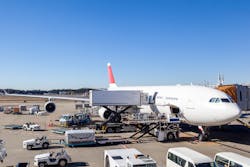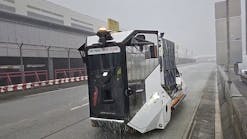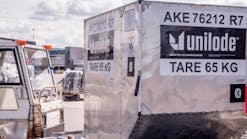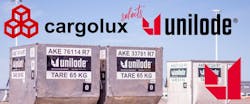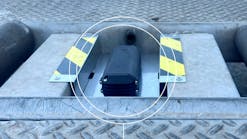Dolly, Container and ULD Tracking Solutions to Optimize Ground Handling
To support on-time performance, ground handlers must be able to effectively manage their cargo handling operations.
One aspect of these operations, which can be especially challenging, is the tracking of dollies, containers and unit load devices (ULDs). Being able to identify the dock location of a ULD, or determine a dolly’s airport apron location, and whether it is loaded or unloaded, is critical to a ground handler’s maintaining control over these resources.
A lack of control has serious consequences, negatively impacting workforce and equipment allocation, productivity, profitability and airlines’ on-time performance.
Fortunately, there are now advanced tracking solutions to mitigate these outcomes. These solutions combine telematics with intelligent dolly, container and ULD management to eliminate the unknowns and bring a real-time view of ground handling equipment’s location and status.
Knowing how these technologies work together is imperative for all ground handlers looking to improve their overall performance and profitability.
The Tracking Solutions Market
According to the market research firm K Berg Insight, the number of active tracking devices for various cargo loading units reached 11.1 million worldwide in 2021. Now growing at a compound annual growth rate (CAGR) of 24.4 percent, that number is expected to increase to 33.1 million in 2026. Currently, Berg’s data estimates that the total market value for cargo container tracking solutions will reach £2.9 billion in 2026.
Driving these numbers are increasing airport construction and expansion projects and capitalization in airport information technology (IT) infrastructure. Additionally, increasing passenger demand is also prompting airports, airlines and ground handlers to implement robust IT solutions that enable them to better manage resources, while also supporting more positive passenger experiences.
Based on research conducted by The Insight Partners, the ground handling software market is experiencing growth worldwide, especially in developing nations, but also in various European countries such as the Nordic nations. The Asia-Pacific (APAC) region is recognized as the most dominant market for ground handling software, followed by Europe. Having some of the world’s busiest airports, North America is also a growing market for more efficient ground handling solutions.
Supporting On-Time Performance in Dolly, Container and ULD Management
Ground handling equipment tracking solutions are essential for ground handlers grappling with problems that include not being able to quickly identify the location of ground handling equipment; staff losing productivity due to their inability to access location and status (i.e., loaded, unloaded, in good condition, damaged, etc.); experiencing unnecessary empty runs; and purchasing more dollies, containers and ULDs than necessary due to inefficient management of these resources.
For ground handlers, being able to capture critical data providing full visibility of equipment location, status and movement at the time it is needed is vital to on-time performance. Thereafter, having the information needed to continually monitor key performance indicators such as quantity of dollies, containers and ULDs; and whether they are at the right locations and their utilization (cycle times, equipment damage, etc.) enables ground handlers to gain greater insight and information for optimal management of these resources.
It starts with the application of artificial intelligence- (AI-) driven optimization software and telematics to facilitate the quick identification of ground handling equipment in order to achieve optimized, real-time allocation and assignment of dollies, containers and ULDs. By combining telematics with process-driven data that eliminates blind spots on the apron, ground handlers can gain a full-view and critical operational awareness of their equipment.
AI and Telematics Working Together
Applying an advanced AI/Telematics tracking solution, ground handlers can gain precise location and status information (i.e., whether a ULD is ready for pickup, the dock to which it was delivered, its loading time, if the ULD has been loaded to a dolly, and where the dolly and ULD is parked on the apron) – in real-time.
Both the AI-driven software and the telematics technology operate together to deliver this critical information and operational awareness to ground handlers. Specifically, the optimization software serves to control the best allocation and assignment of the equipment to the right loading or unloading task. The solution delivers a comprehensive view of the process pertaining to a ULD’s position and destination location. This enables ground handlers to gain real-time access to relevant information regarding a specific ULD.
The telematics component of the tracking solution serves to identify a dolly’s status; its location, its loaded/unloaded status. With this information, ground handlers can achieve faster and more efficient feeding of dollies to the loading process.
With each GSE/dolly specifically identified, other key data can be captured, for example, its maintenance history. This enables ground handlers to then create an operating profile for each GSE/dolly and then use this profile to determine the best course of action for each piece of equipment. In the case of a dolly’s maintenance schedule, instead of relying on a predetermined calendar date, the solution will indicate exactly when maintenance is required, thereby reducing labor and related costs, and promoting increased productivity and operational safety.
The tracking solution also plays a role in dolly fleet size containment. Armed with information on what number of its dollies are typically empty in parking positions, a ground handler can make an informed decision to reduce its fleet.
An additional function of the telemetry data is its role in supporting optimized dispatching of equipment, and ability to facilitate a quick response to unexpected contingencies. When these events occur, the telematics component of the tracking solution can promptly calculate and recommend equipment alternatives in support of service level agreements (SLAs) and optimized decision-making.
Solar-powered, the tracking module does not require battery replacement or any maintenance in support of lower labor and equipment costs. Its operation involves data transmission through an energy-saving, low power wide area network (LPWAN) or alternatively, a 4G Cat M1 (GSM). An additional benefit stems from its decreased data transmission and application of cost-efficient Bluetooth low energy (BLE) tags on dollies. Should direct transmission fail, the network technology will continue its operation, able to locate dollies, including those placed in a building.
Benefits Derived
In summary, dolly, container and ULD tracking solutions are delivering important benefits to ground handlers across key operational areas of on-time performance, asset management and cost containment. By applying these solutions:
- Time consuming, error-prone manual processes can be eliminated.
- Worker productivity can be boosted with less time spent trying to locate equipment and/or determine its status.
- Workflows can be accelerated with optimized operational awareness and decision-making support.
- Contingencies can be managed more effectively.
- Equipment fleet sizes can be reduced.
- Labor and equipment costs can be contained.
- Adherence to customer SLAs can be achieved.
- On-time performance can be maximized.
- Ground handling costs can be contained.
Balancing operational needs with market pressures is not an easy task for ground handlers. A ground handler’s missteps can have serious repercussions, causing a considerable ripple effect on flight schedules and overall airport operations.
In today’s post-pandemic environment, ground handlers are under increased pressure to maximize their use of labor and equipment and operate in the most cost-effective manner. It boils down to this: Having accurate, detailed real-time information enables ground handling equipment to be better utilized and better planned for in terms of required fleet sizes, maintenance schedules and required labor.
With on-time performance and service quality the primary goals, having the optimum tracking solution can support desired time slots along with the most informed and quickest responses to any disruption that must be managed.
Swen Franken is head of the cargo and line maintenance department at INFORM Aviation.
